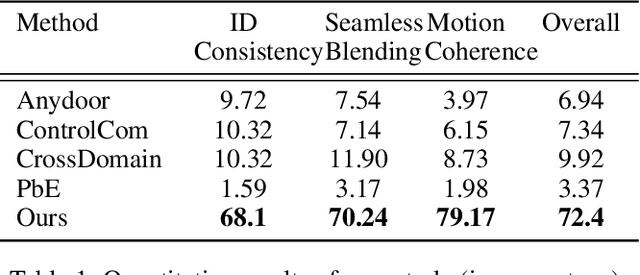Weijing Tao
MotionCom: Automatic and Motion-Aware Image Composition with LLM and Video Diffusion Prior
Sep 16, 2024



Abstract:This work presents MotionCom, a training-free motion-aware diffusion based image composition, enabling automatic and seamless integration of target objects into new scenes with dynamically coherent results without finetuning or optimization. Traditional approaches in this area suffer from two significant limitations: they require manual planning for object placement and often generate static compositions lacking motion realism. MotionCom addresses these issues by utilizing a Large Vision Language Model (LVLM) for intelligent planning, and a Video Diffusion prior for motion-infused image synthesis, streamlining the composition process. Our multi-modal Chain-of-Thought (CoT) prompting with LVLM automates the strategic placement planning of foreground objects, considering their potential motion and interaction within the scenes. Complementing this, we propose a novel method MotionPaint to distill motion-aware information from pretrained video diffusion models in the generation phase, ensuring that these objects are not only seamlessly integrated but also endowed with realistic motion. Extensive quantitative and qualitative results highlight MotionCom's superiority, showcasing its efficiency in streamlining the planning process and its capability to produce compositions that authentically depict motion and interaction.
DivAvatar: Diverse 3D Avatar Generation with a Single Prompt
Feb 27, 2024



Abstract:Text-to-Avatar generation has recently made significant strides due to advancements in diffusion models. However, most existing work remains constrained by limited diversity, producing avatars with subtle differences in appearance for a given text prompt. We design DivAvatar, a novel framework that generates diverse avatars, empowering 3D creatives with a multitude of distinct and richly varied 3D avatars from a single text prompt. Different from most existing work that exploits scene-specific 3D representations such as NeRF, DivAvatar finetunes a 3D generative model (i.e., EVA3D), allowing diverse avatar generation from simply noise sampling in inference time. DivAvatar has two key designs that help achieve generation diversity and visual quality. The first is a noise sampling technique during training phase which is critical in generating diverse appearances. The second is a semantic-aware zoom mechanism and a novel depth loss, the former producing appearances of high textual fidelity by separate fine-tuning of specific body parts and the latter improving geometry quality greatly by smoothing the generated mesh in the features space. Extensive experiments show that DivAvatar is highly versatile in generating avatars of diverse appearances.
 Add to Chrome
Add to Chrome Add to Firefox
Add to Firefox Add to Edge
Add to Edge